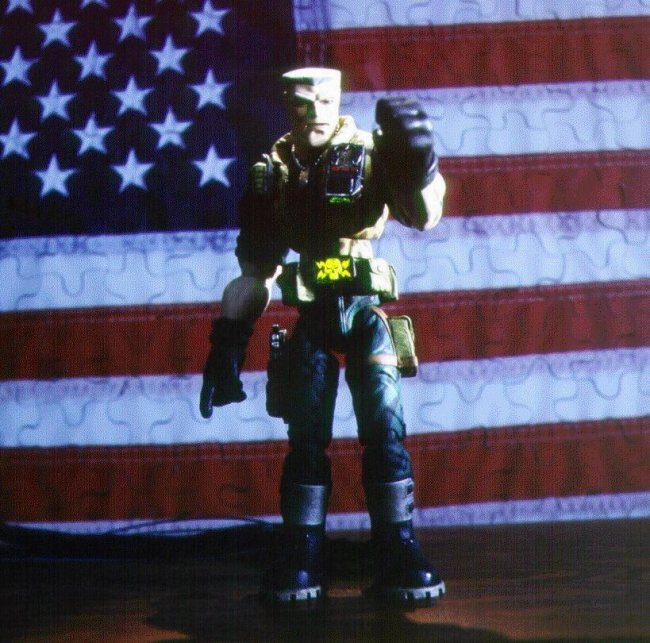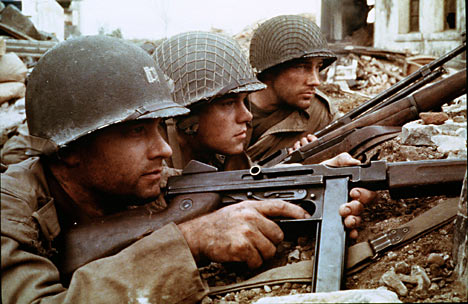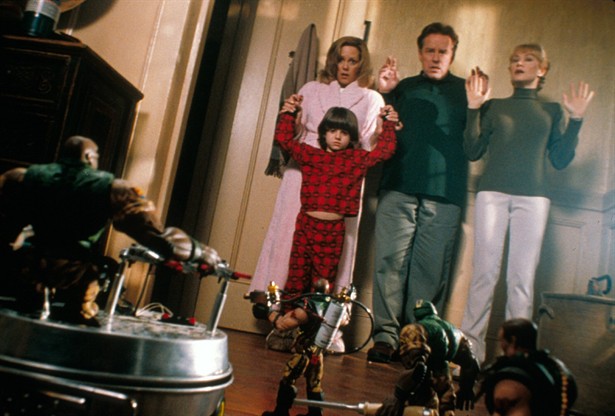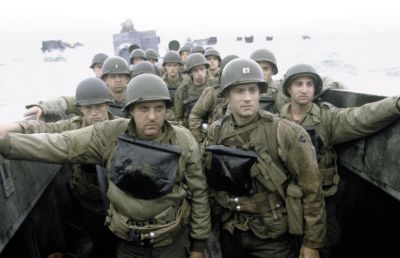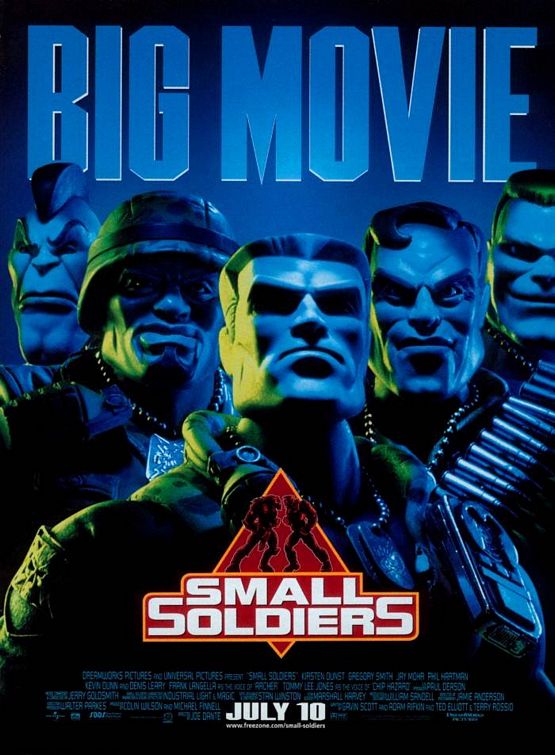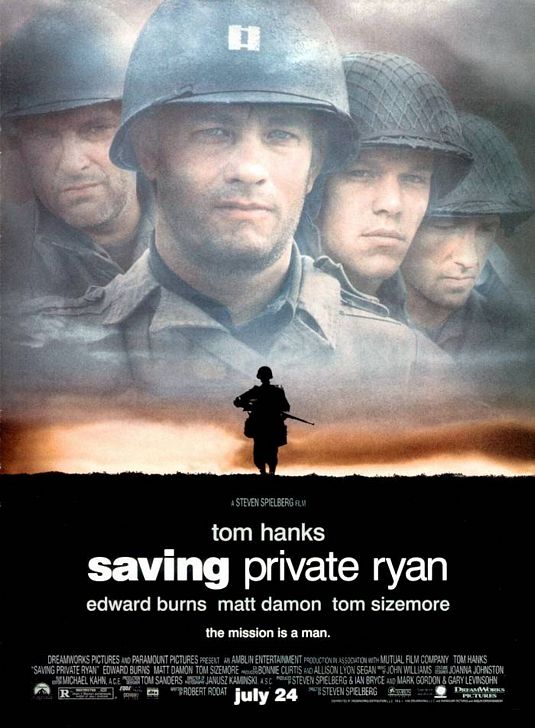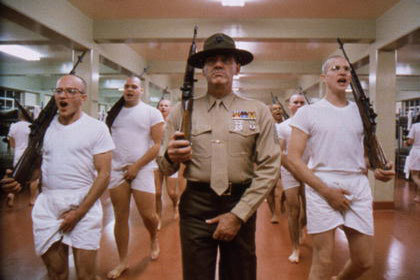One of my best known reviews, from the July 24, 1998 Chicago Reader. For those who’d prefer to read a shorter version of the same argument, I’ll start with my capsule reviews of the two films. — J.R.
Small Soldiers
Director Joe Dante (Gremlins, Innerspace, Explorers, Matinee) is a national treasure, and his lack of recognition by the general public may actually make it easier for him to function subversively. His unpretentious fantasy romps have more to say about the American psyche, pop culture, and the ideology of violence than anything dreamed up by Steven Spielberg or George Lucas. This delightful adventure about war toys running amok in suburban middle America is a synthesis and extension of most of his previous movies, with echoes of Gulliver’s Travels (including some of the satire). The toys in question are the villainous Commando Elite, fashioned using a microchip from the U.S. Defense Department to mercilessly slaughter the noble if freakish Gorgonites, a set of toys programmed (like other minorities one can mention) to hide and to lose; the Ohio citizens who wind up in the cross fire are strictly generic sitcom types, but we wind up caring about them almost as much as we care about the toys. It’s typical of Dante as a pop connoisseur that he adroitly links a creepy sequence about mutated Barbie dolls to Bride of Frankenstein. His films are about not just culture and violence but also everyday cultural violence, something we all have to cope with. Written by Gavin Scott, Adam Rifkin, Ted Elliott, and Terry Rossio; the cast includes Gregory Smith, Kirsten Dunst, Jay Mohr, Phil Hartman (in his last screen role), Kevin Dunn, David Cross, Ann Magnuson, Denis Leary, and Dante standby Dick Miller. (JR)
Saving Private Ryan
Steven Spielberg’s 1998 exercise in Oscar-mongering is a compilation of effects and impressions from all the war movies he’s ever seen, decked out with precise instructions about what to think in Robert Rodat’s script and how to feel in John Williams’s hokey music. There’s something here for everybody — war is hell (Sam Fuller), war is father figures (Oliver Stone), war is absurd (David Lean, Stanley Kubrick), war is necessary (John Ford), war is surreal (Francis Coppola), war is exciting (Robert Aldrich), war is upsetting (all of the preceding and Lewis Milestone), war is uplifting (ditto) — and nothing that suggests an independent vision, unless you count seeing more limbs blown off than usual (the visceral opening sequence, showing Omaha Beach on June 6, 1944) or someone getting graphically shot underwater. The story is about a squad trying to find and send home a private whose three older brothers have already been killed in World War II; it’s a mission ordered by General George C. Marshall (backed by the authority of Abraham Lincoln, who’s backed in turn by Spielberg) and executed by Tom Hanks, a captain named John instead of Joe. It has a few pretty good action moments (including a climax straight out of the Indiana Jones trilogy), a lot of spilled guts, a few moments of drama that don’t seem phony or hollow, some fairly strained period ambiance, and a bit of sentimental morphing that reminds me of Forrest Gump; it also lasts the better part of three hours. With Tom Sizemore, Matt Damon, Edward Burns, Jeremy Davies, Vin Diesel, Adam Goldberg, and Barry Pepper. R. (JR)
Small Soldiers
Rating **** Masterpiece
Directed by Joe Dante
Written by Gavin Scott, Adam Rifkin, Ted Elliott, and Terry Rossio
With Kirsten Dunst, Gregory Smith, Jay Mohr, Phil Hartman, Kevin Dunn, David Cross, Ann Magnuson, Denis Leary, and Dick Miller.
Saving Private Ryan
Rating * Has redeeming facet
Directed by Steven Spielberg
Written by Robert Rodat
With Tom Hanks, Tom Sizemore, Edward Burns, Barry Pepper, Adam Goldberg, Van Diesel, Matt Damon, and Ted Danson.
The other night I happened upon “The Toys of Peace,” a wise and wicked tale by Saki included in A.S. Byatt’s recent collection, The Oxford Book of English Short Stories. Set in 1914, it recounts the noble and doomed efforts of the hero to interest his nine- and ten-year-old nephews in “peace toys”: models of a municipal incinerator and of the Manchester branch of the YWCA, as well as lead figurines of John Stuart Mill, Robert Raikes (the founder of Sunday schools), a sanitary inspector, and a district councillor. Forty minutes after giving the objects to the boys he finds that they’ve converted them into war toys: the incinerator has been punctured to accommodate imaginary cannons, Mill has been dipped in red ink to make him look like an 18th-century French colonel, and a grisly game plan has been mapped out that will yield the maximum amount of bloodshed — the remainder of the red ink is already splashed against the side of the YWCA building.
Saki’s story testifies to the long-standing lure of make-believe war to boys. Even more wicked and wise in some ways is Joe Dante’s Small Soldiers — a trenchant satire masquerading as a summer kids’ movie that’s rude enough to suggest that the emotions and fancies underlying the make-believe war games boys like to play are not so different from the sentiments and fabrications underlying real wars, including our escapades in places such as Vietnam and the Persian Gulf. This is especially true for civilians who watch battles from afar, accepting the mise en scène of newscasters and governments just as kids accept the game plans of toy manufacturers. But it also applies to some of the participants, such as eager enlistees programmed by movies to see warfare as a glorified form of kicking butt. Part of the thesis of Garry Wills’s recent book John Wayne’s America is that it was our fantasies about a movie star that got us into Vietnam. And one could argue that the two most successful American exports — movies and weapons — are aggressive, fantasy-driven toys.
Beginning with a TV commercial for Globotech, a huge conglomerate that boasts about converting weaponry to peaceful uses — “beating swords into plowshares for you and your family” — Small Soldiers whisks us off to the first meeting of Globotech’s CEO (Denis Leary) with two toy designers working for his latest acquisition, Heartland Play Systems. One of these designers, nerdy Irwin (David Cross) — a rough equivalent of Saki’s idealistic hero — believes in making educational, nonviolent toys and has come up with a blueprint for benign, noble monsters known as the Gorgonites, creatures searching peacefully for Gorgon, their ancestral home. The other designer, hyper Larry (Jay Mohr), proposes the Commando Elite, a hard-ass squad of killer soldiers.
Scoffing at Irwin’s qualms about violence and rationalizing his own preferences in movie-entertainment terms (“Don’t call it violence — call it action. Kids love action”), the CEO combines these two projects into a single line of products, designating the mainly white Commandos (miniature Schwarzeneggers and Van Dammes) as good old-fashioned American destroyers and the Gorgonites as their multiracial targets and victims. He then sends both designers off to produce high-tech toys within six months. Eager to please his new boss, Larry filches Irwin’s computer password and uses it to acquire a microchip from the U.S. Defense Department, thereby empowering his Commandos to generate all the “action” required.
When a delivery truck with an early shipment of Commandos and Gorgonites stops in a small town in Ohio, a rebellious teenager named Alan (Gregory Smith) — who’s minding his father’s New Age toy store, the Inner Child — persuades the trucker (Dick Miller) to turn over one set of the new products on consignment. His father (Kevin Dunn) won’t stock war toys, but Alan knows that he can make an easy buck selling them on the sly while his father’s away at a seminar. Alan represents another version of Larry and the CEO’s entrepreneurial spirit, while his ineffectual father represents another version of Irwin’s bumbling idealism. But once Commandos and Gorgonites break out of their boxes and become engaged in a full-scale war — the Commandos programmed to search and destroy, the Gorgonites programmed to hide and eventually lose — the humans in Alan’s house and the family next door, including Christy (Kirsten Dunst), the girl Alan’s pursuing, get caught in the cross fire and are forced to take sides. As everyday domestic objects and appliances are turned into weaponry by the Commandos, the grim undersides of consumer culture and kick-ass ideology come together in riotous, carnivalesque splendor.
The target of Dante’s satire isn’t simply war and warmongering but the everyday cultural violence that encompasses them, by which I mean the violence in pop culture as well as the violence of pop culture. With the possible exception of Innerspace, just about all of Dante’s best work is concerned with this cultural violence — cuddly Spielbergian pets in Gremlins; animated cartoons in “It’s a Good Life,” his segment in Twilight Zone–The Movie; TV in the finale of Explorers; xenophobia in The ‘Burbs; war fever in Matinee; corporate merchandising in Gremlins 2: The New Batch. Part of the exciting achievement of Small Soldiers is that it combines all of these concerns into one streamlined statement. I can’t think of a Hollywood entertainment I’ve enjoyed as much all year, and both audiences I saw the movie with seemed delighted as well. However, most mainstream reviewers seem to despise it, and if they have their way it won’t be around much longer.
It isn’t unprecedented that these reviewers don’t perceive Dante’s efforts as satire or even as art; his major predecessor in American pop cinema, the late Frank Tashlin, was equally misunderstood in this country. Tashlin’s own vision of cultural violence was grounded in animated cartoons — he began as a cartoonist and animator — but the objects of his satirical and parodic scorn were tied to what was most aggressive about American pop culture in the 50s: comic books (Artists and Models), Hollywood (Hollywood or Bust), rock ‘n’ roll (The Girl Can’t Help It), advertising (Will Success Spoil Rock Hunter?), television (Rock-a-Bye Baby), all kinds of media excess, sexual hysteria, loud colors, and gadgets (passim).
As an aficionado of horror and SF movies as well as cartoons, Dante has a different take on cultural aggression and what it consists of, but his fascination with the pop material he mocks and synthesizes rivals Tashlin’s, leading some commentators to conclude that he’s too invested in the material to qualify as a satirist. Just as some critics found Tashlin too vulgar to qualify as a satirist of vulgarity, some critics find Dante’s movies too violent to qualify as satires about violence. I would argue in both cases that the directors’ extreme stylization creates a sense of detachment from what they’re showing that’s the true source of what disturbs people. Nothing is ever perceived as real in their comic fantasies, which means that audiences are forced to reflect on their reactions to what they’re watching and to consider how much they’re the targets of the satire.
A child of the 50s, Dante has the irreverence Mad had when it was still a disreputable, transgressive comic book and before it became a magazine of predictable formats and stances. The loving details and surplus gags tucked away in his artfully composed frames, always harking back to a layered Georges Méliès aesthetic, irresistibly recall the bountiful comic-strip panels of Bill Elder, probably the most inventive of all the original Mad artists. In both its incarnations, Mad represents a democratic impulse to aim equal amounts of derision at everything in its path, though when that path included a number of sacred cows that weren’t being assailed elsewhere it had a more subversive edge — that is, during the time when Mad was still coming out as a comic book (a masquerade comparable to the marketing of Small Soldiers as a kids’ movie). Part of the kick of Dante’s cheerful scorn is that it’s directed not only at obvious targets like The Dirty Dozen (it employs members of that movie’s cast as the voices of the Commandos), but also less obvious ones, such as Apocalypse Now (perceived by many as an antiwar film and hence something of a sacred cow, even in the 90s) — while adroitly exposing the childishness of the overblown epic and heroic stances in all of them. The self-importance of a supposedly balanced portrait like Patton is made to seem just as ludicrous as an imperialist adventure like Rambo, and the consumer aspect of war films in general is kept in the foreground: “World War II is my favorite war,” declares the hero’s TV-buff neighbor (played by the late Phil Hartman), and it seems like a line Steven Spielberg might utter.
One reviewer has complained that he expected something more “cutting edge” from Small Soldiers, something more like what Toy Story offered — apparently thinking of the technology in that cartoon feature. Many other reviewers have decried Dante’s violence as harmful and disturbing to children, again comparing Small Soldiers unfavorably to Toy Story. But the only cutting edge I can recall from Toy Story was used to dismember toy figures. Maybe this is because I find it difficult to isolate technology from what it’s being used for. I don’t have children of my own, yet it’s hard for me to see how an exercise in good-natured, across-the-board ridicule of warmongering like Small Soldiers could traumatize the same kind of kids who were packed off to enjoy the squeezed-out eyes and severed limbs of Toy Story. Unlike the violence in Toy Story or even in an allegedly grown-up movie like Saving Private Ryan — where the brutality is postulated as real within the terms of the story being told — the mutilation of toys in Small Soldiers is always referential, making us think about the mutilation of characters we witness in other movies. This pointedly includes the hypocrisy of such highly validated flag-waving “history lessons” as the graphic carnage in Saving Private Ryan, which are used to simultaneously sell tickets and provide moral correctives to other war movies (though the movies being corrected often upped the violence quotient in their own eras with identical rationalizations and mixed motives).
It’s ironic that every time a director decides to a make a war film more graphic in its violence than its predecessors the argument seems to be, “This‘ll make someone think twice about wanting to go to war.” But the result may well be the opposite. This is another version of the syndrome described in the Saki story, one that has understandably prompted some critics to claim that there’s no such thing as an antiwar war movie — though Spielberg, perennial exploitation apologist that he is, recently claimed that “every war movie, good or bad, is an antiwar movie” (presumably including Sands of Iwo Jima and The Green Berets). One of the finer virtues of Small Soldiers is that it cuts through this kind of crap and makes the very idea of a war film look ridiculous.
One way of partially accounting for the shortsightedness of some reviewers is the mendacity of the ads, which foreground the Commandos as if they were the movie’s unironic heroes rather than its pathetically programmed comic villains — falsely equating the movie’s essence with the crassness of Globotech’s CEO. Thanks to this cheesy promo, I came close to skipping the film — until I read in the fine print that Dante was the director. Don’t we all tend to lay critical grids over films before we see them? I recently discovered in the Realist that the Chinese title of Oliver Stone’s Nixon is The Big Liar; if Stone had had the balls to give his movie that title I probably would have hated it less. (I also have to admit that the aura of hushed respect surrounding Saving Private Ryan made me approach it with suspicion; for that matter, I’m wary of trusting the rhetoric of any director who chooses to begin and end a picture with the waving of an American flag.)
I don’t mean to suggest that Dante’s distancing effects, which the ads go to such pains to deny, preclude strong emotions. Sometimes the results are creepy — as when the Commandos create a flock of lethal mutants out of Christy’s collection of Barbie dolls (to the accompaniment of Franz Waxman’s eerie theme music from Bride of Frankenstein) or when they subsequently converge on a house with some of the predatory menace of George Romero’s zombies. And the mocking satire of the Commandos and most of the human characters doesn’t prevent an emotional response to the tragic, wizened nobility of Archer, the simian leader of the Gorgonites (a reflection of Dante’s solidarity with outcasts). Many of his fellow Gorgonites are cartoon versions of Famous Monsters of Filmland — the giant alien eye from It Came From Outer Space, Frankenstein’s monster, the Hunchback of Notre Dame — and the fact that they’re programmed to hide as well as lose is poetically apt given the way such icons are routinely swept to the margins of a pop media culture that places a higher premium on the “action” of explosive killing machines. Nonlethal Gorgonites and Commandos are already being sold in toy stores, and it will be interesting to see the relative grosses. Given the audible pleasure the Gorgonites provoked both times that I saw the film, I’d like to think they were outselling their enemies. But it’s possible that the movie’s ad campaign is having a bigger effect.
A master of deception and a superb storyteller, an expert businessman who periodically tries to parlay his talent for taking our money into a mission to perform Good Works, Steven Spielberg certainly qualifies as a huckster with a conscience. But what exactly defines that conscience? I would suggest that it’s Joe Dante, because Spielberg’s sponsorship has made significant portions of Dante’s work possible, including Gremlins, “It’s a Good Life,” and Small Soldiers. The fact that Gremlins is a blatant send-up of the concept of benign, cuddly aliens promulgated in Close Encounters of the Third Kind and E.T. and that Small Soldiers ridicules the agenda of films like Saving Private Ryan is part of what makes his sponsorship so fascinating — and it’s worth adding that Spielberg’s encouragement of Dante’s anti-Spielbergian projects goes beyond tolerance. I once met Dante in the mid-80s, and he told me that the studio was ready to cut the morbid monologue in Gremlins about a Santa Claus’s death while coming down a chimney when Spielberg stepped in to save it.
Other people might define Spielberg’s conscience as his desire and capacity to go beyond profitable romps of racist slaughter (the Indiana Jones trilogy) and theme-park rides (his dinosaur diptych) — his own contributions to cultural violence — to nobler purposes, such as paying heed to black oppression (The Color Purple and Amistad), the Holocaust (Schindler’s List), and World War II (Empire of the Sun and Saving Private Ryan). But it’s Spielberg’s Irving G. Thalberg Award persona, his use of hustler techniques to further such noble projects — administering his cultural violence from Mount Olympus — that gives me pause.
As someone who’s preferred Poltergeist (produced and partly directed by Spielberg) to E.T. ever since they came out in successive weeks in 1982, I’m not saying that I value the disreputable teenager side of Spielberg’s personality more than the responsible adult side, which is how many critics would define the split. In fact, I think his two best pictures, Close Encounters of the Third Kind and Schindler’s List, derive their power more from his innocence than from any effort to prove he’s a grown-up. His faith in the benevolence of buglike aliens and a capitalist saint, and the awe he expresses about both mysteries, results in equally speculative and equally narcissistic self-portraits. The difference between these pictures lies in the radical distinction between fantasies about flying saucers and hard facts about the Holocaust — but these are the differences we bring to these pictures, not the differences Spielberg brings, except incidentally. For when it comes to hard facts about the Holocaust and Schindler himself, Schindler’s List is clearly inferior to — even unworthy of — Thomas Keneally’s nonfiction novel; it’s only the speculative awe that Spielberg brings to the material that makes it his own.
What I’m saying is that self-deception is central to Spielberg’s achievements — as central to them as deceiving the public, because the two activities ultimately amount to the same thing. We wouldn’t be nearly so open to accepting the seriousness of Spielberg’s “grown-up” projects if he weren’t so adept at doing con jobs on himself. It surely takes a combination of innocence and showbiz smarts to persuade an audience to contemplate the Holocaust by first getting them to identify with a Nazi who enjoys going to ritzy nightclubs. The same mentality led Spielberg to tell Stephen Schiff of the New Yorker that he received an enormous amount of pleasure from giving money to charities without telling anyone — without telling anyone, that is, except Schiff and millions of readers. That’s why the man capable of claiming that Jaws was “his” Vietnam and that “every war movie, good or bad, is an antiwar movie” can persuade people that Saving Private Ryan is something more than just another recruiting film.
I’ll never forget escorting the late Samuel Fuller, the much-decorated World War II hero and maverick filmmaker, to a multiplex screening of Full Metal Jacket, along with another critic, Bill Krohn, 11 years ago. Though Fuller courteously stayed with us to the end, he declared afterward that as far as he was concerned, it was another goddamn recruiting film — that teenage boys who went to see Kubrick’s picture with their girlfriends would come out thinking that wartime combat was neat. Krohn and I were both somewhat flabbergasted by his response at the time, but in hindsight I think his point was irrefutable. There are still legitimate reasons for defending Full Metal Jacket — as a radical statement about what conditioning does to intelligence and personality, as a meditation about what the denial of femininity does to masculine definitions of civilization, as a deeply disturbing experiment in sprung and unsprung narrative, and perhaps as other things as well. But as a piece of propaganda against warfare, it’s specious, providing one more link in an endless chain of generic macho self-deceptions on the subject. The principal achievement of Saving Private Ryan is to extend that sort of self-deception into the 90s — with patriotic and patriarchal slop ladled on top of it, but none of the strengths or virtues of Kubrick’s movie.
I don’t mean to suggest that Spielberg’s movie doesn’t have virtues of its own. The extended combat sequence that comes just after the prologue — “June 4, 1944/Green Dog Sector/Omaha Beach” — is a virtuoso piece of filmmaking that boldly throws us into what Globotech’s CEO calls action before any of the characters or plot have been established. The underlying message of course is “This is what it was really like” — a critique of all preceding war films for not showing us enough bodies being torn apart. (Come to think of it, I’ve also never seen a body spurt blood underwater after being sprayed with bullets, or blood smeared on a camera lens; chalk up two more innovations for Spielberg.)
But for all the care and thoughtfulness that follow in the story, I never could shake the impression that all I was watching was every other war film Spielberg had ever seen. The same chestnuts implicitly critiqued in the opening mayhem soon reappear, and it becomes clear that the major lesson Spielberg has to teach us about war is what he’s learned from a lifetime of moviegoing. And what he’s learned turns out to be something for everyone rather than a single vision: war is hell, war is absurd, war is necessary, war is unnecessary, war is uplifting, war is depressing, war is a lesson in morality, war is a lesson in immorality, and so on. Along with John Williams’s insufferably solemn and hokey music and the fruits of what I’m sure was tons of research, I got mainly secondhand memories of All Quiet on the Western Front, Fuller’s war films, Kubrick’s war films, The Bridge over the River Kwai, and third-hand memories of John Ford’s war films and many others.
Even touches that are made to look revisionist — like the eagerness of some American GIs to shoot a POW — are reprises of bits from Fuller’s The Steel Helmet and other pictures. As James Wolcott notes in the August Vanity Fair, 50s war films set in Korea tended to be seen by kids at the time as World War II movies: “Same format, different foe.” The tendency of the public imagination to collapse all 20th-century wars together, which Small Soldiers has a lot of fun with, is also detectable in many of Spielberg’s borrowings — one of the reasons I found the period ambience unconvincing much of the time.
A squad is ordered by General Marshall (Harve Presnell) — backed by the wisdom of Abraham Lincoln, for further patriarchal reinforcement — to retrieve Private James Ryan (Matt Damon) from France and send him home after all three of his brothers are reported dead on other battlefronts. The squad is commanded by the enigmatic Captain John Miller (Tom Hanks, touching as usual, in his standard everyman part), and over the course of their hazardous mission each man is led to question whether what he’s doing is worth the effort.
The answers are yes, no, and maybe, and these are eventually summarized and synthesized in a memorable speech by a dying soldier — after a bit of climactic spectacle that combines a gag from an Indiana Jones adventure with the complacent soul-searching of an Oscar-winning David Lean moment about the futility of warfare. This is followed by an exquisite morphing effect that’s straight out of Forrest Gump, a reprise of General Marshall quoting Lincoln, an emotional reprise of Schindler’s lament that he didn’t save the lives of more Jews, and a reprise of the American flag waving. In other words, real stuff for the troops.

